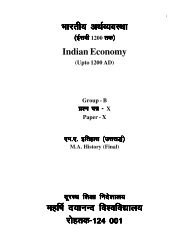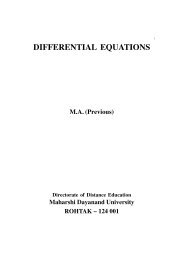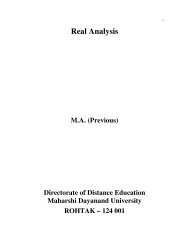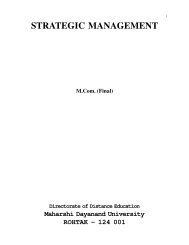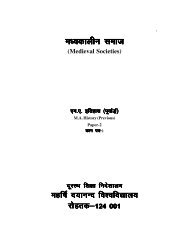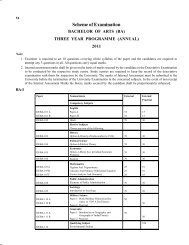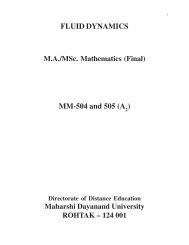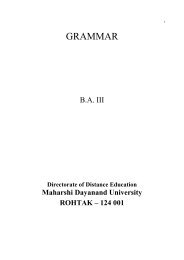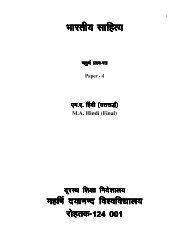LITERATURE AND GENDER - Maharshi Dayanand University, Rohtak
LITERATURE AND GENDER - Maharshi Dayanand University, Rohtak
LITERATURE AND GENDER - Maharshi Dayanand University, Rohtak
You also want an ePaper? Increase the reach of your titles
YUMPU automatically turns print PDFs into web optimized ePapers that Google loves.
Girish Karnad – Nagamandal‘Another school of drama had arisen in the 1930s, at the height of the struggle for national independence. When socialreform was acknowledged as a goal next only to independence in importance, a group of ‘realistic’ playwrights hadchallenged the emptiness and vapidity of Parsi drama. The contemporary concerns of these playwrights gave theirwork an immediacy and a sharp edge lacking in the earlier theatre, and a few plays of great power were written.While trying to awaken their audience to the humiliation of political enslavement, many of these new playwrightsmade a coruscating analysis of the ills that had eaten into Indian society. This was essentially the playwright’s theatre;the plays were presented by amateur or semiprofessional groups and were mostly directed by the playwrights themselves.Unlike in the Par.3i theatre, where a hardheaded financial logic was the guide, here the writers, the actors, and theaudience were all united by a genuine idealism. They created a movement, if not a theatre, for the times.Although its form aimed at being realistic, it must be pointed out at once that this drama concentrated on only a smallcorner of the vast canvas explored by Western realistic theatre.The door banged by Nora in ‘The Doll’s House’ did not merely announce feminist rebellion against social slavery. Itsummed up what was to be the main Concern of Western realistic drama over the next hundred years: a person’sneed to be seen as an individual, as an entity valuable in itself, independent of family and social circumstance. Indianrealism, however, could not progress beyond analyses of social problems, for in India, despite the large urban population,there really has never been a bourgeoisie with its faith in individualism as the ultimate value. ‘Westernization’notwithstanding, Indians define themselves in terms of their relationships to the other members of their family, caste,or class. They are defined by the role they have to play. In Sudhir Kakar’s words, the), see themselves in ‘relational’terms in their social context, and they naturally extend the same references to theatre as well.Let me give an example. A few years ago Arthur Miller’s A View from the Bridge was presented in Madras. EddieCarbone, the play’s protagonist, is an Italian dock worker. He is a good man but tragedy is brought about by hisincestuous passion for his orphaned niece. He harbours two young, illegal Italian immigrants in his house, one ofwhom falls in love with the niece. Consumed by jealousy, Eddie breaks his code of honour, betrays the immigrants tothe authorities, and is killed by one of them.The audience watching the play in Madras was English educated, familiar with Western literature. Many of them frequentlywere-abroad and had a living contact with the Western way of life. The production was a success. But most of the audienceentirely missed the element of incest in the play; rather, they chose to ignore it as an unnecessary adjunct to an otherwiseperfectly rational tale. After all, Eddie was his niece’s guardian, a surrogate father. It was only right that he should beinterested in her welfare. You certainly could not blame him for trying to safeguard her future. On the contrary, the illegalimmigrants emerged as unsympathetic, for they had betrayed their host’s confidence by seducing the niece’s affections.Even apart from consideration of social roles that led the Madras audience to write its own A View from The Bridge,Eddie Carbone perfectly fits an Indian archetype: the father figure aggressing toward its offspring. Our mythology isreplete with parental figures demanding sacrifices from their children-as in my own Yayati— Eddie’s position was notone in which the Indian audience was likely to find any tragic flaw.To get back to realistic theatre, its great improvement over the Parsi theatre was that it took itself seriously both as artand as an instrument of social change. Yet it remained saddled with the European model. Bernard Shaw was itspresiding deity. The proscenium continued, only now the grand spectacles gave way to the interior set with theinvisible fourth wall. And that three-walled living room succinctly defined the basic limitation of this school of writing.From Ibsen to Albee, the living room has symbolized all that is valuable to the Western bourgeoisie. It is one’s refugefrom the sociopolitical forces raging in the world outside, as well as the battleground where values essential to one’sindividuality are fought out and defended. But nothing of consequence ever happens or is supposed to happen in anIndian living room! It is the n:)-man’s-land, the empty, almost defensive front the family presents to the world outside.Space in a traditional home is ordered according to the caste hierarchy as well as the hierarchies within the family.Whether a person is permitted inside the compound, allowed as far as the outer verandah, or admitted into the livingroom depends on his or her caste and social status. And it is in the interior of the house, in the kitchen, in the room wherethe gods are kept, or in the backyard, where family problems are tackled, or allowed to fester, and where the women can47



